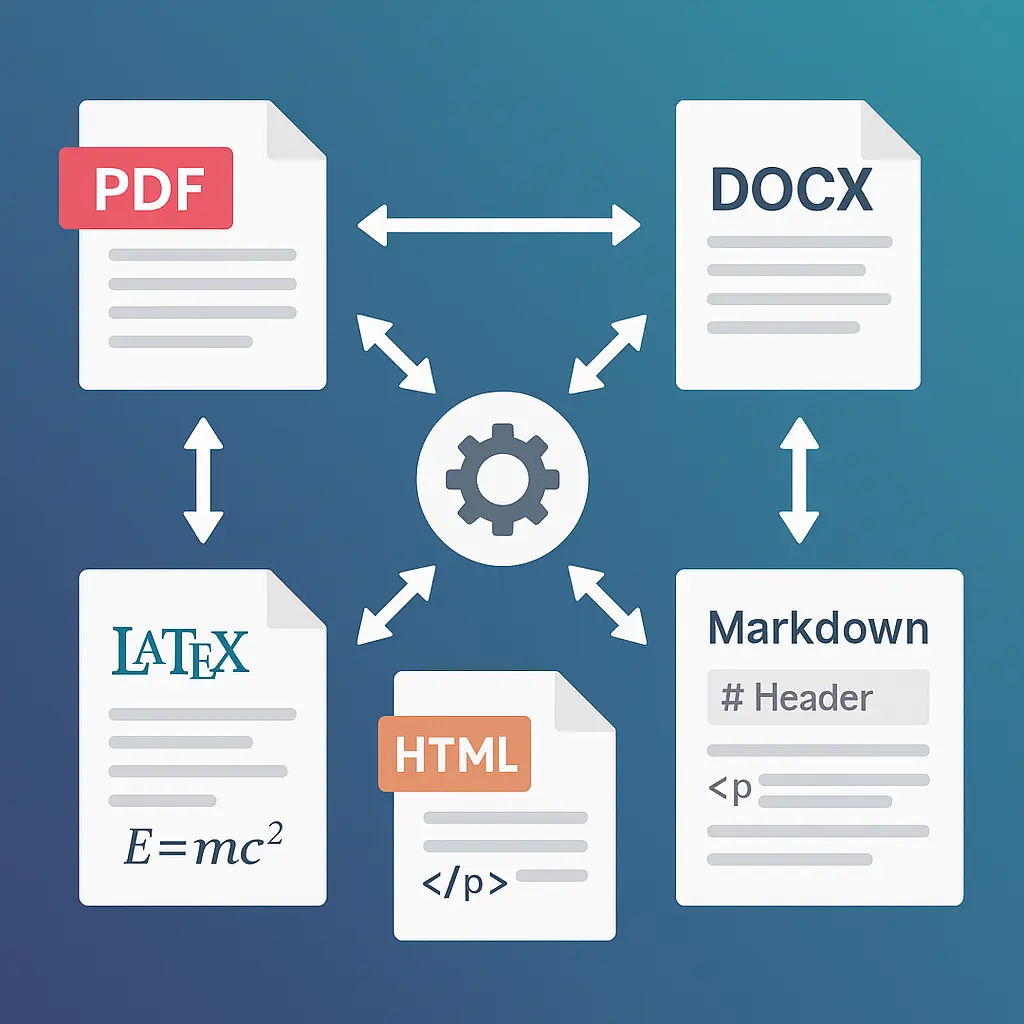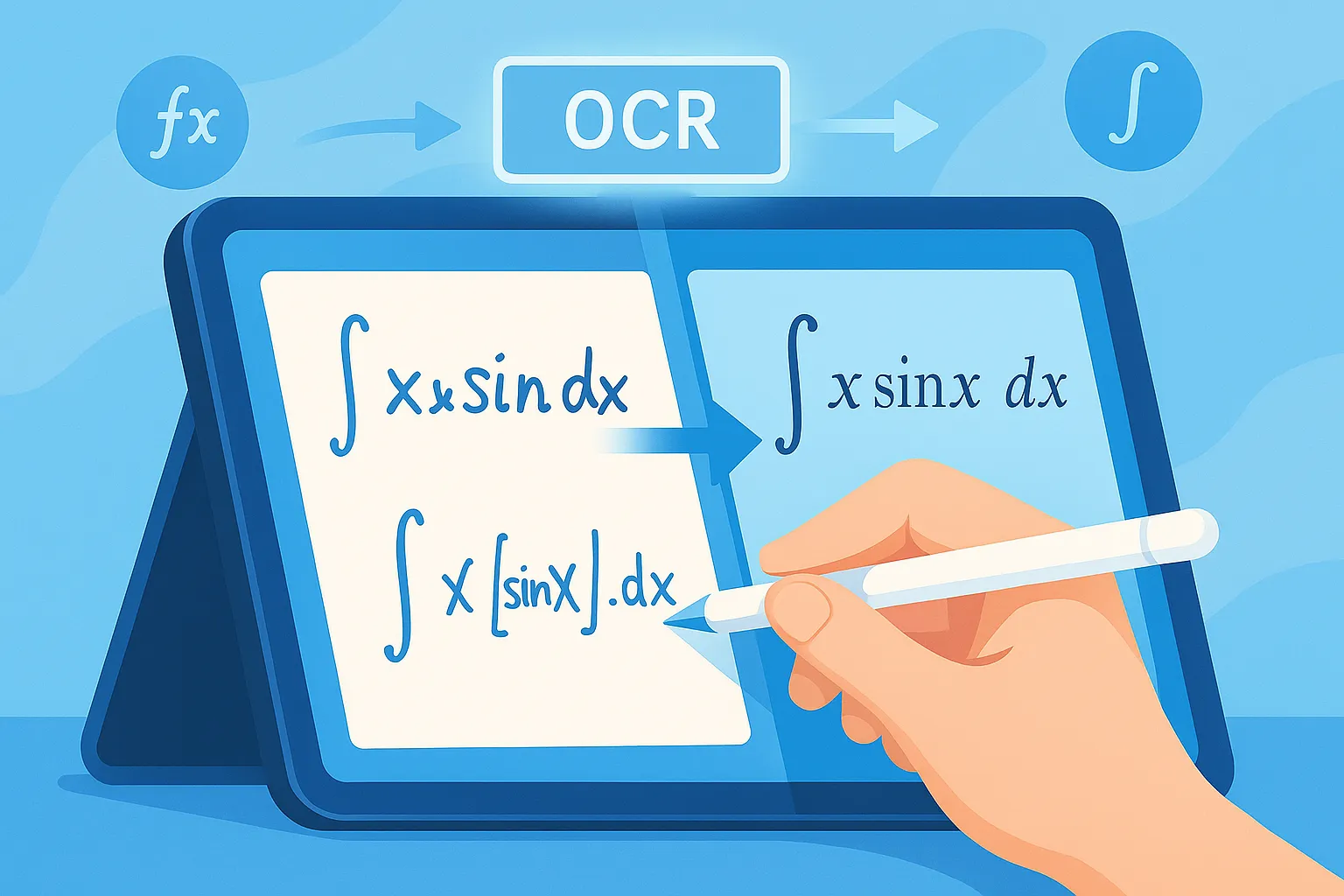Working with mathematical notation across different platforms? Need to convert $x^2 + 2x + 1$ from LaTeX to MathML for your web app, or translate AsciiMath to Unicode for a document? Mathematical expressions come in many formats, and converting between them manually is tedious and error-prone.
This guide explains the most common math notation formats and shows you how to convert between them instantly and accurately.
🎯 Try it now: Use our free Math Format Converter to convert between LaTeX, MathML, AsciiMath, MathJSON, and Unicode formats instantly.
💡 Pro tip: LaTeX is the most portable format—when in doubt, convert to LaTeX first, then to your target format. This two-step approach often yields better results than direct conversion.
📸 Ready to convert math between any format? Try MathPad Free →
Why Convert Math Formats?
Different platforms and applications use different mathematical notation systems:
- Web pages: MathML for native browser rendering
- Academic papers: LaTeX for publication-quality typesetting
- Simple text: AsciiMath for human-readable math
- APIs & Data: MathJSON for structured machine-readable math
- Plain text: Unicode for basic mathematical symbols
Converting between these formats is essential when:
- Publishing research papers or documentation
- Building web applications with math content
- Integrating math into different software systems
- Sharing mathematical expressions across platforms
- Archiving or migrating mathematical content
Common Math Notation Formats
LaTeX
LaTeX is the gold standard for mathematical typesetting in academic publishing.
Format:
\frac{-b \pm \sqrt{b^2 - 4ac}}{2a}
Use cases:
- Academic papers and publications
- Mathematical documentation
- Research collaboration
- Professional typesetting
Pros: Universal support, publication-quality output, extensive documentation Cons: Verbose syntax, requires learning curve
MathML (Mathematical Markup Language)
MathML is an XML-based standard for displaying math in web browsers.
Format:
<math>
<mfrac>
<mrow>
<mo>-</mo><mi>b</mi>
<mo>±</mo>
<msqrt>
<msup><mi>b</mi><mn>2</mn></msup>
<mo>-</mo>
<mn>4</mn><mi>a</mi><mi>c</mi>
</msqrt>
</mrow>
<mrow><mn>2</mn><mi>a</mi></mrow>
</mfrac>
</math>
Use cases:
- Web applications
- Accessibility requirements
- Semantic math representation
- Machine processing
Pros: Native browser support, accessible, semantic Cons: Extremely verbose, difficult to write by hand
AsciiMath
AsciiMath provides a simple, human-readable notation that converts to MathML.
Format:
(-b +- sqrt(b^2 - 4ac))/(2a)
Use cases:
- Quick note-taking
- Educational contexts
- Simple web forms
- Casual math communication
Pros: Easy to read and write, intuitive syntax Cons: Limited to simpler expressions, less widely supported
MathJSON
MathJSON is a JSON-based format for representing mathematical expressions programmatically.
Format:
["Divide",
["Add",
["-", "b"],
["Sqrt", ["Subtract", ["Power", "b", 2], ["Multiply", 4, "a", "c"]]]
],
["Multiply", 2, "a"]
]
Use cases:
- API data exchange
- Computer algebra systems
- Math expression trees
- Programmatic manipulation
Pros: Machine-readable, structured, easy to parse Cons: Not human-readable, verbose for simple expressions
Unicode Math
Unicode provides special characters for basic mathematical notation.
Format:
−b ± √(b² − 4ac)
─────────────────
2a
Use cases:
- Plain text documents
- Emails and messaging
- Social media
- Simple text editors
Pros: Works everywhere, no special software needed Cons: Limited symbol set, no complex layout
Supported Format Conversions
Our Math Format Converter supports bidirectional conversion between all major mathematical notation formats. Here's a complete reference table:
All Supported Conversions
| From Format | To LaTeX | To MathML | To AsciiMath | To MathJSON | To Unicode | To Spoken |
|---|---|---|---|---|---|---|
| LaTeX | ✓ (identity) | ✓ | ✓ | ✓ | ✓ | ✓ |
| AsciiMath | ✓ | ✓ | ✓ (identity) | ✓ | ✓ | ✓ |
| MathJSON | ✓ | ✓ | ✓ | ✓ (identity) | ✓ | ✓ |
| Unicode | ✓ | ✓ | ✓ | ✓ | ✓ (identity) | ✓ |
Output-only formats:
- MathML: Available as output from any format (LaTeX, AsciiMath, MathJSON, Unicode)
- Spoken Text: Natural language description available as output from any format
Popular Conversion Pairs
The most commonly used conversions:
| Conversion | Use Case | Example |
|---|---|---|
| LaTeX → MathML | Web publishing, HTML pages | \frac{1}{2} → <mfrac><mn>1</mn><mn>2</mn></mfrac> |
| AsciiMath → LaTeX | Converting simple notation to professional | x^2 + 1 → x^{2} + 1 |
| LaTeX → AsciiMath | Simplifying complex expressions | \sqrt{x^2} → sqrt(x^2) |
| LaTeX → Unicode | Plain text documents, emails | \alpha → α |
| LaTeX → MathJSON | API integration, data processing | x + 1 → ["Add", "x", 1] |
| MathJSON → LaTeX | Converting structured data to readable math | ["Power", "x", 2] → x^{2} |
| Any → Spoken | Accessibility, screen readers | \frac{1}{2} → "one half" |
Conversion Quality
All conversions maintain mathematical accuracy and structure:
- Lossless: LaTeX ↔ MathJSON, LaTeX → MathML
- High-fidelity: AsciiMath → LaTeX, Unicode → LaTeX
- Semantic: All formats → Spoken Text
Common Conversion Scenarios
LaTeX to MathML
Converting LaTeX to MathML is essential for web applications that need semantic math representation.
Example:
- Input (LaTeX):
\int_{0}^{\infty} e^{-x^2} dx = \frac{\sqrt{\pi}}{2} - Output (MathML):
<math><mrow>...</mrow></math>(semantic XML structure)
Use case: Embedding equations in accessible web pages
LaTeX to AsciiMath
Simplify LaTeX for casual use or educational contexts.
Example:
- Input (LaTeX):
\frac{a}{b} + \frac{c}{d} - Output (AsciiMath):
a/b + c/d
Use case: Quick collaboration with non-LaTeX users
AsciiMath to LaTeX
Convert simple notation to professional typesetting.
Example:
- Input (AsciiMath):
sum_(i=1)^n x_i - Output (LaTeX):
\sum_{i=1}^{n} x_i
Use case: Turning notes into publication-ready content
LaTeX to Unicode
Create plain text representations of math expressions.
Example:
- Input (LaTeX):
\alpha + \beta = \gamma - Output (Unicode):
α + β = γ
Use case: Social media posts, plain text documents
MathJSON to LaTeX
Convert programmatic math representations to human-readable form.
Example:
- Input (MathJSON):
["Add", ["Power", "x", 2], 1] - Output (LaTeX):
x^{2} + 1
Use case: Displaying computer-generated math to users
Conversion Best Practices
Choose the Right Pivot Format
LaTeX serves as an excellent pivot format for multi-step conversions:
AsciiMath → LaTeX → MathML
This approach often yields better results than direct conversion.
Validate Your Output
Always verify converted expressions:
- Visual check: Render both input and output to compare
- Semantic check: Ensure mathematical meaning is preserved
- Edge cases: Test with fractions, exponents, special symbols
Handle Special Characters
Different formats have different escape sequences:
- LaTeX:
\alpha,\beta,\Gamma - Unicode:
α,β,Γ - MathML:
<mi>α</mi>,<mi>β</mi>,<mi>Γ</mi>
Preserve Structure
Complex expressions need proper grouping:
- Use parentheses/braces consistently
- Maintain fraction structures
- Keep superscripts/subscripts aligned
Common Pitfalls
Lost Semantics
Some conversions lose semantic meaning:
Problem: Converting \frac{1}{2} (fraction) to Unicode ½ (character)
Solution: Use MathML for semantic preservation
Encoding Issues
Unicode math characters can cause encoding problems:
Problem: √ displays as ? in some editors
Solution: Ensure UTF-8 encoding throughout your pipeline
Incomplete Coverage
Not all symbols translate between formats:
Problem: Some LaTeX commands have no Unicode equivalent Solution: Fall back to descriptive text or images
Whitespace Handling
Different formats treat spaces differently:
LaTeX: Ignores most whitespace AsciiMath: Whitespace can be significant MathML: Preserves all whitespace
Integration Tips
Web Applications
For dynamic math on web pages:
- Accept input in user-friendly format (LaTeX or AsciiMath)
- Convert to MathML for rendering
- Store in LaTeX for portability
Documentation Systems
For technical documentation:
- Write in LaTeX for precision
- Convert to target format on build
- Cache conversions for performance
APIs and Data Exchange
For programmatic use:
- Use MathJSON for structured data
- Convert to LaTeX for human display
- Validate with CAS engines
Frequently Asked Questions
Which format is best for archiving?
LaTeX is the best choice for long-term archiving. It's:
- Plain text (survives software changes)
- Widely documented
- Human-readable
- Supported by archival standards
Can I convert handwritten math?
Not directly—handwritten math needs OCR first. Use tools like MathPix to convert images to LaTeX, then convert to other formats.
How do I handle matrices and tables?
Different formats have varying matrix support:
- LaTeX: Full matrix environments (
\begin{pmatrix}) - MathML: Table-based matrix elements
- AsciiMath: Limited matrix notation
- Unicode: Box-drawing characters only
Are conversions always accurate?
Most conversions are accurate for standard notation. Edge cases to watch:
- Custom LaTeX macros (won't convert)
- Rare Unicode symbols (may lack equivalents)
- Complex layouts (may lose structure)
Always validate critical conversions visually.
Can I batch convert files?
Our converter handles single expressions. For batch conversion:
- Extract all math expressions
- Convert each individually
- Reassemble in target format
- Validate output
Ready to Convert?
Stop struggling with manual format conversion. Our Math Format Converter handles all major formats with instant, accurate bidirectional conversion.
Key features:
- ✅ LaTeX ↔ MathML ↔ AsciiMath ↔ Unicode
- ✅ MathJSON support for APIs
- ✅ Live preview of output
- ✅ Copy with one click
- ✅ Free forever
Need more math tools? Check out our Derivative Calculator, Integral Calculator, and Math to Image Converter for comprehensive math support.
Have questions about math format conversion? Contact us or check out our full suite of math tools.



